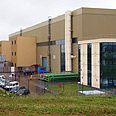
Israel plays key role in CERN super collider exercise
Forty Israeli scientists part of team that built European Centre for Nuclear Research particle accelerator complex, meant to simulate Big Bang Theory. Team said to work closely with Lebanese, Iranian scientists. Science knows no enemies, says senior Israeli researcher
It has been called an Alice in Wonderland investigation into the makeup of the universe – or dangerous tampering with nature that could spell doomsday; but scientists involved in a historic "Big Bang" experiment scheduled to begin this week in Geneva hope it will turn up many surprises about the universe and its origins – but reject suggestions it will bring the end of the world.
The multibillion-dollar large Hadron Collider, the most powerful atom-smasher ever built, will explore the tiniest particles and come ever closer to re-enacting the big bang, the theory that a colossal explosion created the universe.
The collider, built by the European Centre for Nuclear Research (CERN), is designed to push the proton beam close to the speed of light, whizzing 11,000 times a second around the tunnel 150 to 500 feet under the bucolic countryside on the French-Swiss border.
Once the beam is successfully fired counterclockwise, a clockwise test will follow. Then the scientists will aim the beams at each other so that protons collide, shattering into fragments and releasing energy under the gaze of detectors filling cathedral-sized caverns at points along the tunnel.

A model of super collider (Photo: GettyImages)
Robert Aymar, the French physicist who heads the CERN research centre, predicted that discoveries to emerge from his organization's $9.2 billion project would spark major advances for human society.
"If some of what we expect to find does not turn up, and things we did not foresee do, that will be even more stimulating because it means that we understand less than we thought about nature," said British physicist Brian Cox.
Cosmologists say that that explosion of an object the size of a small coin occurred about 13.7 billion years ago and led to formation of stars, planets and eventually – life on earth.
A key aim of the CERN experiment is to find the "Higgs boson," named after Scottish physicist Peter Higgs who in 1964 pointed to such a particle as the force that gave mass to matter and made the universe possible. But other mysteries of physics and cosmology – super symmetry, dark matter and dark energy among them – are at the focus of experiments in the 17-mile circular tunnel deep underneath the Swiss-French border.
A global collaboration
The project has attracted researchers of 80 nationalities, some 1,200 of them from the United States, which contributed $531 million of the project's price tag of nearly $4 billion.
Israel, in many ways, is one of the key players in helping make the super collider come to life, as 40 Israeli scientists from the Technion and the Tel Aviv and Haifa universities have spent the better part of the past 10 years developing several of its main electronic systems, particularly the core's detector system - which is charged with deciphering and analyzing the results of the unprecedented experiment.
"The Israeli science industry has a stellar reputation in Switzerland, especially when in comes to high level fiber-optic technology," said Professor Giora Mikenberg from the Department of Particle Physics at the Weizmann Institute, who heads the Israeli team.
The project also brought about several unexpected collaborations, with Israeli scientists working side by side with Lebanese, Pakistani and Iranian counterparts. But one cooperative effort stood out the most, that of the warm bonds forged with a young Palestinian scientist from the Birzeit University.
When work on the project ended the Israeli team even organized a celebratory party together with the Lebanese and Palestinian scientists. Both Israeli and Palestinian flags were hung.
One day, Mikenberg recalled, suffering from joint hunger pangs for some decent hummus, the Lebanese, Palestinian and Israeli scientists "swung by Paris and scarfed some down, Israeli and Arab together. Science knows no borders and no enemies. It's a wonderful thing."
"This only happens once in a generation," added Katie Yurkewicz, spokeswoman for the US contingent at the CERN project. "People are certainly very excited."
Bringing about the end of the world?
CERN , the European Centre for Nuclear Research, said Tuesday that its key researchers have been inundated by e-mails voicing fears about the experiment.
"The LHC will enable us to study in detail what nature is doing all around us," Aymar, who has led CERN for five years, "The LHC is safe, and any suggestion that it might present a risk is pure fiction."
In the first tests, a particle beam will be shot all the way around the LHC channel in just one direction. If all goes well, collisions might be tried within the coming weeks, but at low intensity. Any bangs at this stage, said one CERN researcher, "will be little ones."
The multibillion-dollar Large Hadron Collider, the most powerful atom-smasher ever built, will explore the tiniest particles and come ever closer to re-enacting the big bang, the theory that a colossal explosion created the universe.
But the skeptics have filed suit in US District Court in Hawaii and in the European Court of Human Rights to stop the project. They unsuccessfully mounted a similar action in 1999 to block the Relativistic Heavy Ion Collider at the Brookhaven National Laboratory in New York State.
CERN's collider has been under construction since 2003, financed mostly by its 20 European member states. The United States and Japan are major contributors with observer status in CERN.
Dudi Goldman, the Associated Press and Reuters contributed to this report















